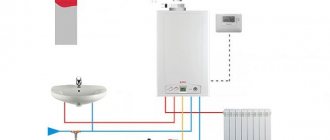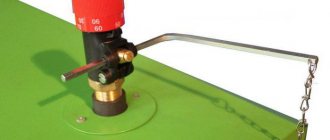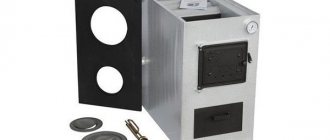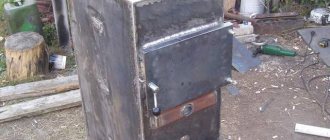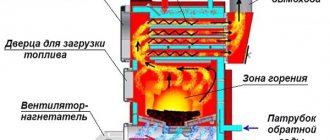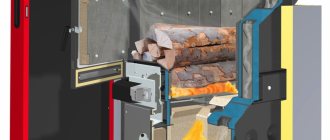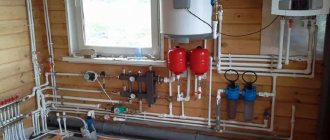When purchasing and installing a solid fuel boiler, it is necessary to take into account the peculiarities of its operation, namely the high probability of overheating in emergency situations, which can result in a serious accident and even destruction of the water jacket of the unit (explosion). Also, considerable harm can be caused by the formation of condensation on the walls of the combustion chamber, which happens under certain operating conditions. To eliminate such troubles, the solid fuel boiler must be protected from overheating and condensation, which will be discussed in our article.
Why does a solid fuel boiler boil and explode?
There is only one reason - the large inertia of the boiler.
If there is a sudden stop in heat extraction, the boiler cannot go out quickly. The coolant in the boiler boils, and the increased pressure ruptures the boiler. Modern heating systems are energy dependent. They have a circulation pump installed, or even several pumps.
The circulation pump circulates the coolant in the heating system and boiler. If circulation stops, the solid fuel boiler will boil.
For this reason, many people like gravity or gravity heating systems. It does not contain elements that require electricity. This is the only advantage of a gravity system. I can’t even imagine what needs to be done to make the boiler boil with such a heating system.
Placing an order
— an order can be placed:
1) call the office by phone 8(925)936-19-59
and order equipment through the manager
2) send an application by email
3) place an order via the feedback form or “add the required product to cart”
Attention! Processing of an application or calculation of equipment is carried out only if you have: contact information with telephone number, details (for legal entities)!
* For large orders (without our selection of equipment), a written application is necessary for prompt calculation.
— delivery is made in agreement with the manager by phone
— You can place retail orders in our retail store
Options for protecting solid fuel boilers from overheating
A cheap and simple option for protecting a solid fuel boiler from boiling is a source of uninterrupted power supply. This is an inverter and an electric battery.
How does an uninterruptible power supply work?
The circulation pump and boiler fan are connected via an inverter to the electrical network. When there is a power outage in the network, the inverter begins to take electricity from the battery, converting it from 12 V to 220 V. When electricity appears in the network, the inverter switches and begins to charge the battery.
Uninterruptible power supply cost
The cost of a UPS depends on the power of the inverter and the capacity of the batteries. We need to ensure circulation, so we look at the characteristics of the circulation pump, which ensures the circulation of coolant in the boiler.
In our case it is a 25/40 pump. Its power, if it operates at first speed, is 36 W. We will not connect the fan to the UPS, because... We heat with wood, and when burning with wood, a fan is not needed.
Are you using a boiler fan or is your circulation pump running at different speeds? The battery selection formula is below.
Calculation of the required battery capacity
To determine the required battery capacity, you can use the formula:
E = P*T/K/U/Keff, E – Battery capacity, A/h K – Battery depth of discharge coefficient (we recommend 0.7) U – Battery voltage, V P – Power of connected electrical appliances, W T – Necessary uninterruptible operation time, h Efficiency - Efficiency of the uninterruptible power supply (assumed 0.8)
Example: Power consumption 36 W, battery voltage 12 V, required reserve time 8 hours.
E = 36*8/0.7/12/0.8 = 42.85 A/h
A battery with a capacity of 45 A/h costs about 9,000 rubles. An inverter with a power of 400-500 W will cost about 7,000 rubles.
Causes of overheating
The only reason for overheating is that the boiler produces more heat than is consumed by the heating system. But if everything was fine before, and now the boiler is overheating, then the problem is not that the boiler is very powerful, but the problem is something else.
It is possible that you simply have a clogged dirt filter in front of the circulation pump. In this case, you need to unscrew it and clean it and the problem will be solved. If you have this problem, your return will be cold.
There is an option that the circulation pump is simply broken. If you have this problem, your return will also be cold. Change the pump.
But the most common problem is overheating as a result of a power outage. Everything is perfect for you - a clean filter, a working pump, but it just can’t work. And overheating occurs. You can solve the problem by extinguishing the boiler or pulling out the burning fuel from the boiler firebox - but this is far from the best option. The best option is to make the heating system insensitive to power outages - make it gravity-fed or install an uninterruptible power supply.
Watch a video showing how the boiler overheats when the power supply is turned off.
And here is a video with a method for solving the problem of overheating of the boiler and heating system.
A true boiler repair specialist is hard to find.
Therefore, it is important to understand them yourself, because a specialist is really not always required and many problems can be eliminated yourself. Let's look at the list of boiler faults, which maximally covers all possible breakdowns
The article is intended for a non-specialist, but an ordinary person who can eliminate such problems.
Why is condensation harmful?
At first glance, there is nothing wrong with the fact that some amount of water appears inside the boiler. Sooner or later it will still evaporate under the influence of high temperatures of the flue gases. However, everything is not so simple here. In fact, the condensate does not contain pure water, but a weak solution of acids. In addition, complete evaporation of condensate may never happen if it appears in too large quantities.
Despite the low concentration, the acids in the condensate can corrode the metal body of the boiler even during one season of active operation of the unit. In a properly configured heating system, this will never happen. But the piping of the heat generator, performed with errors, leads to the formation of condensate during the entire operating time of the boiler. As a result of this, it accumulates and continuously affects metal surfaces, gradually destroying them.
The second problem associated with the appearance of condensation is that soot particles begin to stick to it. During the combustion of fuel, a certain amount of soot is released into the flue gases, most of which leaves the boiler through the chimney to the street. However, if there is any condensation on the surface of the heat exchanger, a small percentage of soot will permanently adhere to these droplets.
As a result, over time, a fairly dense layer appears on the heat exchanger. If, in addition, wet wood is used during the operation of the heat generator, this deposit also contains various flammable resins. The gradual thickening of such a crust leads to a drop in the efficiency of the boiler, since it insulates the metal body of the heat exchanger from the heat of heated gases. The temperature from the furnace to the coolant is transferred worse and worse with each subsequent switching on of the heat generator.
Another danger associated with the formation of soot and resin deposits on the surface of the heat exchanger is the fire hazard of this mixture. The boiler must be cleaned at least once every three weeks. This is necessary to remove residues of fuel combustion products adhering to the walls of the unit. If this standard is not followed, the resulting crust may catch fire and lead to a fire hazard.
There is one feature in heat generator maintenance that is not so obvious at first glance, but becomes the main reason for cleaning the boiler too rarely. The point is that modern solid fuel units have a rather complex structure, which is specially calculated to increase the efficiency of the device.
As a result, a large number of intricate ornate passages inside the boiler significantly complicate the process of cleaning it. As a result, over time, any desire to perform this procedure with the necessary regularity disappears. For the same reason, some parts of the structure cannot be accessed at all, which once again confirms the need to solve the problem with condensation.
Why is the riser hot and the batteries cold?
Sometimes, with a hot supply, the return of the heating battery still remains cold. There are several main reasons for this:
- installation was performed incorrectly;
- the system or one of the risers of a separate radiator is airborne;
- insufficient fluid flow;
- the cross-section of the pipe through which the coolant is supplied has decreased;
- The heating circuit is dirty.
Cold return is a serious problem that must be eliminated. It entails many unpleasant consequences: the temperature in the room does not reach the desired level, the efficiency of radiators decreases, and there is no way to correct the situation with additional devices. As a result, the heating system does not work as it should.
The main trouble with cold return is the large temperature difference that occurs between the supply and return temperatures. In this case, condensation appears on the walls of the boiler, reacting with carbon dioxide, which is released during fuel combustion. As a result, acid is formed, which corrodes the walls of the boiler and shortens its service life.
Condensation protection
Plaque deposited on the internal walls accelerates the wear of the boiler and shortens its service life. Accumulating moisture has less impact on cast iron, since it is not susceptible to corrosion.
One way to protect the boiler from condensation is to introduce a three-way thermostatic valve. It is adjusted to a coolant temperature of about 55-60 °C and operates as follows:
- while the water is heated to a given temperature, it circulates through a small circuit of the system;
- when the specified value is reached, the valve mixes water into the main circuit;
- the risk of sudden temperature changes is eliminated, condensation does not appear in the firebox.
It is not always necessary to separately purchase and install a three-way valve - some manufacturers implement devices with similar functions in their products. However, if necessary, you can purchase such mixing units for 20-30 thousand rubles.
What is the expansion tank for?
The expansion tank is usually installed in the attic. Most often, this room is not heated. Based on this, there is a need to insulate the walls of the expansion tank. Otherwise, in the cold season, the water in it will completely freeze. The tank compensates for changes in water temperature. In addition, water may boil in the boiler, especially if the boiler is heated too intensely. Due to the formed bubbles, the volume increases. This is what the additional volume in the expansion tank is for.
Expansion tank
It is recommended to pay attention to the release of excess water from the tank when it overflows. You will have to consider the presence of drainage into a sewer or septic tank.
Using the Safety Valve
This is not the same thing as a safety valve. The latter simply relieves pressure in the system, but does not cool it. Another thing is the boiler overheating protection valve, which takes hot water from the system and instead supplies cold water from the water supply. The device is non-volatile and is connected to the supply and return lines, water supply network and sewerage system.
When the coolant temperature is above 105 ºС, the valve opens and, thanks to the pressure in the water supply system of 2-5 Bar, hot water is forced out of the heat generator jacket and pipelines with cold water, after which it goes into the sewer. How the solid fuel boiler protection valve is connected is shown in the diagram:
The disadvantage of this method of protection is that it is not suitable for systems filled with antifreeze liquid. In addition, the scheme is not applicable in conditions where there is no centralized water supply, because along with a power outage, the supply of water from a well or pool will also stop.
Circuit with emergency bypass
The scheme below for protecting a solid fuel boiler from overheating has practically no disadvantages:
When the power is turned off, the circulation pump will stop, which during operation presses the petal of the check valve, thereby preventing the movement of water through the bypass. But after stopping, the valve will open and the coolant will continue to circulate naturally. Even if at this time some kind of accident occurs with the solid fuel boiler and the heating of the water does not stop, the heat will be transferred to the buffer tank until the wood in the firebox burns out.
About three way valve
The device comes in two types:
- distribution;
- mixing
The first is installed on the supply pipeline, the second on the return pipeline. The valve's job is to regulate not only temperature, but also fluid flow. The device never closes or opens it completely. The valve itself is closed only when the boiler is started.
The mixing and distribution valves are non-volatile. They do not require additional devices or controllers. Heating of the coolant on a small circle is completed in 15-20 minutes. Sometimes an hour is not enough to warm up the water in the entire system.
The cost of a thermostatic valve is from 5 to 7 thousand rubles. Even taking into account installation costs, this is more profitable than buying a mixing unit. Moreover, the valve provides the same effective removal of condensate.
The occurrence of condensation or overheating can be minimized at the system design stage. This applies, for example, when choosing pipes from a certain material.
Polymer products are more susceptible to high heat. It is better to wire the heater with copper or steel, and attach polypropylene elements to the distribution manifold. The presence of a metal pipe in the “return” section between the three-way valve and the boiler pipe is of particular importance - the temperature sensor on the polymer will react to overheating with a delay.
How does a thermostatic distribution valve work?
The thermostatic valve is installed on the supply in front of the bypass section (pipeline section) connecting the supply and return of the boiler in close proximity to the boiler. This creates a small coolant circulation circuit. The thermoflask, as mentioned above, is installed on the return pipeline in close proximity to the boiler.
At the moment of boiler startup, the coolant has a minimum temperature, the working fluid in the thermoflask occupies a minimum volume, there is no pressure on the thermohead rod, and the valve allows the coolant to flow only in one direction of circulation in a small circle.
As the coolant heats up, the volume of the working fluid in the thermoflask increases, the thermal head begins to put pressure on the valve stem, passing the cold coolant to the boiler, and the heated coolant into the general circulation circuit.
As a result of mixing cold water, the temperature in the return line decreases, and, therefore, the volume of the working fluid in the thermal flask decreases, which leads to a decrease in the pressure of the thermal head on the valve stem. This in turn leads to the cessation of the supply of cold water to the small circulation circuit.
The process continues until the entire coolant is heated to the required temperature. After which the valve blocks the movement of the coolant through the small circulation circuit, and the entire coolant begins to move through the large heating circle.
The thermostatic mixing valve works in the same way as a distribution valve, but it is installed not on the supply pipe, but on the return pipe. The valve is located in front of the bypass, connecting the supply and return and forming a small circle of coolant circulation. The thermostatic flask is mounted in the same place - on a section of the return pipeline in close proximity to the heating boiler.
While the coolant is cold, the valve allows it to flow only in a small circle. As the coolant heats up, the thermal head begins to put pressure on the valve stem, allowing part of the heated coolant to pass into the general circulation circuit of the boiler.
As you can see, the scheme is extremely simple, but at the same time effective and reliable.
The thermostatic valve and thermal head do not require electrical energy to operate; both devices are non-volatile. No additional devices or controllers are needed either. To heat the coolant circulating in a small circle, 15 minutes are enough, while heating the entire coolant in the boiler can take several hours.
This means that using a thermostatic valve, the duration of condensation formation in a solid fuel boiler is reduced several times, and along with it, the time of the destructive effects of acids on the boiler is reduced.
To protect a solid fuel boiler from condensation, it is necessary to properly piping it, using a thermostatic valve and creating a small coolant circulation circuit.
When purchasing and installing a solid fuel boiler, it is necessary to take into account the peculiarities of its operation, namely the high probability of overheating in emergency situations, which can result in a serious accident and even destruction of the water jacket of the unit (explosion). Also, considerable harm can be caused by the formation of condensation on the walls of the combustion chamber, which happens under certain operating conditions. To eliminate such troubles, the solid fuel boiler must be protected from overheating and condensation, which will be discussed in our article.
How to avoid condensation in a turbine boiler
Models with a closed burner are equipped with a coaxial chimney. It has a slope of 3° in the outward direction, i.e. from the boiler, it ensures spontaneous drainage of condensate to the street.
The internal channel of the coaxial system is constantly cooled by the air flow coming from outside, due to which the temperature difference during normal operation is minimal.
The standard length of a coaxial smoke exhaust system is 1.2 meters. If extension is necessary, (necessarily indoors) the distance should not exceed 6 meters. There must be at least 0.6 m between the outlet of the outer part of the coaxial chimney and the nearest obstacle (wall, large tree, etc.).
If the boiler is equipped with a coaxial chimney, problems with condensation formation arise during frosty periods. They are solved by insulating the part of the smoke duct located outside the house, increasing ventilation or starting the boiler at full power.
When using a boiler with a coaxial chimney in the northern regions, it is advisable to insulate the outer part of the exhaust pipe. This way you can prevent the formation of condensation on the chimney of a gas boiler. After all, the difference between the temperatures of the incoming air flow and the outgoing flue gases will be reduced.
You can temporarily provide the boiler with air flow from the room. Most turbine models of floor-standing and wall-mounted gas boilers are designed for the possibility of installing separate supply and exhaust systems. You just need to find the plug for the hole to which the exhaust pipe should be connected and open it slightly.
With the exhaust duct plug slightly open, you can wait out the frost. Then it should be covered tightly. In these cases, it also helps to increase the boiler power during frosty periods. In automated systems, a temporary reduction in the interval between the boiler activation and shutdown temperatures set by the owners works well.
How to fix the problem?
We remind you once again: if gas equipment overheats, contact a specialist immediately. If repairs are delayed and the security system fails, the boiler may even explode.
Filters are clogged
Check the filters first. Turn off the boiler and wait until the water cools down. Turn off all taps and remove filters. If they are clogged, wash them in a solution of citric acid, or clean them with a soft brush. If the filters are completely worn out, it is better to replace them.
Air jams
Water boiling can also occur when the heating system is aired. Air can not only slow down the movement of the coolant, but also stop it completely.
Touch the radiators with your hand. If they warm up unevenly, an air lock has most likely formed. To do this, specialists use special equipment that detects cold spots in the heating circuit.
So, in case of air jams, follow the following algorithm of actions:
- place a basin or pan under the Mayevsky tap, and then open it;
- The air will begin to hiss and water will begin to flow. Do not close the tap until all the liquid has drained and all excess air has been released;
- repeat until the air lock disappears.
Heat exchanger clogged
Even when using high-quality coolant, during constant operation, various salts form on the pipes and walls of the heat exchanger. Due to scale, the passages narrow, the pressure decreases, and the water boils.
This is why experts recommend annual maintenance of gas boilers. During diagnostics, a specialist will assess the condition of the heat exchanger and flush it if necessary. If the heat exchanger is destroyed, then it will have to be replaced.
In addition to regular maintenance, fill the heating circuit with “soft” water or install magnetic filters and change them once a month.
Circulation pump malfunction
If you use a closed heating system, then check the operation of the pump. If not used for a long time, its parts could become stuck or clogged - usually the problem is solved by washing it.
Incorrect operation of the smoke removal system
Heating of the boiler body can occur if the smoke removal system is malfunctioning, and the heat exchange surface on the burner side may be dirty or clogged with soot.
Check the presence of draft in the chimney and the flow of combustion air into the room. Let the specialists clean and adjust the gas fittings.
High boiler power or low water flow
The problem can also arise if the power of the device is chosen incorrectly. For example, with high power and low water flow. The coolant simply will not have time to cool.
It is best to eliminate this problem at the stage of installation and purchase of equipment. Consult with specialists, they will calculate your needs and suggest the necessary equipment parameters.
If the heating system is already installed, try to increase the water flow. Install a more powerful pump, buy faucets with larger cartridges, replace watering cans with versions with more holes.
Or contact specialists for help in adjusting and configuring the device. It may be necessary to reduce the gas pressure.
Place of installation of boiler equipment
Make sure that there is no high humidity or low temperature in the room where the boiler is installed. Otherwise, the metal will gradually deteriorate due to corrosion.
Is it possible to drain condensate into the sewer?
During operation of a gas boiler, oxides are formed that react with water vapor. As a result, carbonic and sulfuric acids are formed, the average pH of which is 4. For comparison, the pH of beer is 4.5.
The acidic solution is so weak that there are no restrictions on discharge into public sewers. This rule applies if condensation has formed on the pipe of a gas boiler operating in an apartment.
The only condition is that the condensate must be diluted with wastewater 1 to 25. If the boiler power is more than 200 kW, it is necessary to install a condensate neutralizer. This requirement is indicated by the manufacturer in the equipment passport.
It is impossible to collect condensate into an autonomous sewer system that discharges wastewater into a septic tank with anaerobic bacteria or into a deep treatment station using anaerobes and aerobes. It will destroy the biological environment involved in the cleaning process.
Determining the probability of condensation formation
Calculations can be carried out if condensation is formed as a result of a large release of steam and overheating of the chimney walls, and the power of the operating equipment is known. The average rate of heat release is 1 kW per 10 sq. m.
The formula is relevant for rooms with ceilings below 3 m:
MK = S*UMK/10
MK - boiler power (kW);
S is the area of the building where the equipment is installed;
WMC is an indicator depending on the climate zone.
Indicator for different climatic zones:
- south - 0.9;
- north - 2;
- middle latitudes - 1.2.
When operating a double-circuit boiler, the resulting MK indicator should be multiplied by an additional coefficient (0.25).
Requirements for the chimney of gas boilers
Today, in the construction of chimneys for gas boilers, various materials are used, most of which are impractical. The quality of execution also leaves much to be desired.
Chimney made of asbestos cement. In the past, such chimneys had no alternative. Their main advantage is low cost.
Flaws:
- installation is carried out exclusively on vertical sections of pipes;
- heavy weight and length, which complicates installation;
- joints are not sealed;
- the resulting moisture is absorbed into the walls;
- the temperature of the exhaust gases is not higher than 300 ºС.
It is important to connect the boiler to the chimney correctly. A tee is used for this purpose.
If a tee is used in the chimney, then installation is carried out “through the smoke”. In its absence, “by condensation”
A condensate drain and a cleaning hatch are required.
Brick chimneys. This material is not recommended for installing systems with gas boilers. According to the requirements specified in the collection SNiP 41-01-2003, smoke exhaust channels for gas processing equipment must be smooth and classified as class P in terms of gas tightness.
If a brick smoke duct is quite suitable in terms of gas tightness characteristics, then there can be no talk at all about the smoothness of the walls inside the pipe. Even if the seams of a brick pipe are perfectly sanded with mortar flush with the brickwork, during operation the relief will still appear due to the difference in the density of the material and the binder.
The ideal solution would be to install a metal sleeve inside the brick channel or assemble it from ceramic modules. A brick pipe with a metal or ceramic insert inside can last more than 30 years without problems.
Furanflex lining is suitable for the same purpose. This polymer hose is made of composite (plastic reinforced with high-strength fibers). It is resistant to acid condensate and has low thermal conductivity. Permissible temperature of use is up to 200 ºС.
Ceramic smoke channels. This material is strong and durable. A ceramic chimney is resistant to aggressive acids, easy to maintain and fireproof.
Ceramics can heat up quickly and take a long time to cool down. Installation of such a chimney requires the participation of specialists. The downside is the high cost.
Galvanized and steel. When exposed to moisture, steel rusts. The maximum shelf life of such pipes is up to three years. Galvanized chimneys, protected from rust by a layer of zinc, last for five years or more.
If moisture does not penetrate into the boiler, it accumulates in the lower part of the chimney (in the house), which leads to an unpleasant odor. At the same time, this is a vulnerable place where acid accumulates, which over time will “eat away” this area
Stainless steel pipes. An ideal choice for arranging the smoke duct of a gas boiler. Its installation will cost several tens of times less than the construction of a brick chimney. The walls are smooth, soot and resins will not settle on them, the gas density is quite high.
Chimney problems
Often, when using a solid fuel boiler, little attention is paid to the chimney. But the operation of the entire heating system depends almost 100% on it. There is not enough draft - the power of the boiler is lost, the boiler begins to smoke. A chimney of a smaller diameter is used - also leads to a significant reduction in power, since there will not be enough oxygen to burn the required amount of fuel per unit time. A cold pipe, no insulation - condensation occurs, which begins to flow down the walls of the pipe into the boiler.
If the pipe is insulated, but a thick-walled steel pipe is used, then condensation will form until the entire pipe warms up. If it is a pellet boiler, then it will be quite difficult to warm up such a pipe, since the exhaust gases have a low temperature. In addition, a pellet fuel boiler in the mode of maintaining the room temperature may remain off for a long time, and when it is turned on, condensation will form again. Therefore, for any pellet boilers, we recommend using only insulated sandwich pipes (they usually have a wall thickness of up to 1 mm). As a last resort, you can connect the boiler to a brick chimney. Long-burning boilers can also operate in combustion modes with low flue gas temperatures, so it is also advisable to use sandwich pipes and brick chimneys for them. If the boiler will mainly be operated at maximum power modes, then thick-walled insulated pipes can be used.
In order to reduce the cost of purchasing a chimney, it is enough to insulate the part of the chimney located in unheated rooms and on the street. In addition, in this case, part of the heat from the uninsulated pipe will be transferred into the room, further reducing heating costs.
A cold brick pipe can also collapse from such acid. Over time, traces of such exposure are noticeable on the chimney and smoke begins to flow into the premises of a private house through the seams in the brickwork. You should use high-quality solid bricks and fill masonry joints with high quality. It is recommended that the pipe wall thickness be at least 25cm. To connect the brick pipe to the boiler, you can use a steel bend of a suitable size.
The easiest and most expensive way to solve problems with a chimney is to use a ready-made insulated stainless steel pipe - a sandwich pipe. Such a pipe consists of two concentric pipes, between which there is insulation. The thickness of the insulation layer and the material of the inner pipe are selected based on the characteristics of the heating boiler. Boiler characteristics include flue gas temperature and fuel used. For solid fuel boilers, pipes made of high-quality stainless steels that are resistant to aggressive environments are used, for example, AISI 304, 310 or 316 steel. Sandwich pipes are quite lightweight, and their installation is not difficult. The pipes are inserted into one another using clamping clamps. There are various connecting elements of such smoke systems - tees, transitions from the boiler pipe to the main pipe, bends, passages through walls, passages through ceilings and roofs.
You can use an asbestos-cement chimney. However, such pipes are “afraid” of too hot flue gases. Therefore, it is recommended to make a section of about 2 meters at the boiler outlet from a steel pipe, and then use asbestos-cement pipe.
Rules for the operation of chimneys
When installing a chimney, it is important to ensure:
- removal of condensate using a condensate collection tank;
- maximum tightness of the system;
- system isolation;
- good traction;
- vertical shape of the chimney;
Important! The head of the pipe must rise above the roof surface by at least 0.5 m so that it does not fall into the wind pressure zone.
Installation and maintenance of a chimney is a vital process that cannot be neglected. From time to time, professional regular cleaning and inspection of the chimney is necessary. After all, a visit from a specialist will not only help solve immediate problems, but will also reveal shortcomings in the future.
Are power outages dangerous?
Sellers of non-volatile appliances and uninterruptible power supplies tell customers chilling stories that look quite plausible. A person who does not understand anything at all about the design of a boiler will believe that if the current is lost, the gas supply to the burner continues.
What's really going on? When the temperature sensors, electronic control unit and pump are turned off, uncontrolled combustion of fuel occurs in the combustion chamber, which means overheating of the liquid in the heat exchanger.
Accordingly, the tubes cannot withstand, they become deformed, burst, and the water from them extinguishes the burner of the atmospheric gas boiler. Gas enters the room and creates an explosive situation or simply poisons people and animals. And if a forced-air ventilation system is installed in the boiler, go outside. This is also unsafe and not environmentally friendly.
In fact, electrically dependent boilers occupy a leading position in the sales market. They are installed in holiday villages, private houses, with owners spending half a day at work, and in non-residential premises where long-term repairs are being carried out.
Power outages, as mentioned earlier, are quite common. And for some reason there is no data on hourly large-scale tragedies of carbon monoxide poisoning or explosions.
Moreover, such a dangerous device would not be certified and could not in any way comply with GOST, which means that gas workers would not allow it to be used.
And now the technical details. In fact, the devices have a reliable system that ensures that the boiler is turned off in the event of force majeure, including a power outage.
Where does condensate come from?
What is condensate? The first thing we think of when we hear the word “condensate” is water. Yes, this is a liquid that forms on the surface walls in the form of drops. However, condensate in a heating system during fuel combustion has a different chemical structure. It consists of low concentration acid. Where does it come from? There are several reasons for this:
- Firstly, water is released from the air entering the boiler, the temperature of which is much lower than that of the gases released during fuel combustion, so it settles on the metal walls of the heating equipment.
- Secondly, when starting a solid fuel boiler, the water in the system is still cold, and the water in the boiler warms up much faster. As a result of a large temperature difference, condensation forms.
- Thirdly, when using wet firewood for kindling, moisture is also released, which subsequently settles on the walls of the chimney. Although manufacturers indicate that the moisture content of firewood should not exceed 20%, not all users of solid fuel boilers comply with this requirement.
- Fourthly, the formation of tarry droplets in the chimney is facilitated by the use of fuel based on tarry species, for example, pine and spruce.
But besides the above reasons, there is the most common one, which quickly leads to the destruction of the walls of the boiler, heat exchanger and chimney - this is the incorrectly calculated power of the solid fuel boiler.
How does this happen in practice? Often, users deliberately install a more powerful boiler in order to delay the time of throwing in the next portion of fuel, but do not think about the fact that in the combustion chamber, due to reduced demand, it does not burn completely, but simply smolders for a longer time. The result of slow smoldering is the formation of resin drops on the inner walls of the boiler, which do not evaporate, harden and over time turn into one large crust, which reduces the efficiency of the boiler and leads to rotting of its walls.
What is a thermostat for electric heating boilers? Its main functions and types
A thermostat for an electric heating boiler, regardless of its operating principle, is equipment that is capable of controlling the operation of the heating element, depending on the temperature of the coolant in the home heating system or on the ambient temperature. A simplified diagram of the operation of any thermostat can be represented as follows: on the equipment panel, the user sets the desired temperature range of either the coolant in the heating circuit or the air in the room. The thermostat turns on the boiler.
The latter operates until the temperature of the coolant or air reaches the specified upper limit. Next, the thermostat turns off the heating element of the boiler. The heating automatically turns on when the room temperature does not drop below the limit specified on the thermostat. As a result, such automation for electric heating boilers without constant human control is capable of maintaining the desired microclimate in the house and allows for rational use of energy.
The thermostat for an electric heating boiler can be mechanical and electronic, wired and wireless. The price varies depending on the type of equipment. Each type of thermostat has its own advantages and disadvantages.
What is a safety group for heating and is it possible for the circuit to operate without it?
Mechanical thermostats
This is what a mechanical thermostat looks like.
They are based on either bimetallic plates or gas- or liquid-filled bellows. The latter work very simply. Under the influence of elevated temperature, the substance filling the bellows is capable of expanding, thereby blocking or opening (depending on the ambient temperature) the coolant flow, which, in turn, affects the operation of the main heating element. The boiler turns on/off.
A bimetallic thermostat for an electric heating boiler works as follows: the bimetal under the influence of high temperature is capable of bending, thereby opening the electrical network. As a result, the heating element of the electric boiler is turned off. As the temperature drops, the plate is leveled again, the circuit is closed, and the boiler resumes operation. As a result, the batteries become warm. By the way, vacuum heating radiators are an excellent solution if you want to save money.
The advantages of a mechanical thermostat for an electric heating boiler:
- ease of operation;
- low cost;
- durability;
- resistance to power surges in the network.
- low sensitivity;
- deviation from the specified temperature range by 2-3 degrees.
Electronic thermostats
The electronic thermostat is equipped with a display.
This is a complex system that can maintain the desired temperature in a room for a long period of time without human intervention. Such automation for electric heating boilers consists of a remote sensor and a control unit. The latter directly affects the operation of the boiler. The remote sensor is connected to the heating element via wires or remotely. The sensor takes temperature readings in the control room, and according to the readings, the operation of the electric boiler is controlled. It turns on or off.
Electronic automation for electric heating boilers and its advantages:
- multifunctionality (responsible for the operation of the boiler, circulation pump, etc.);
- accuracy (minor deviations from human-set temperature parameters);
- independence (equipment can operate without human intervention from 8 hours to 1 week);
- several operating modes.
Experts recommend choosing a thermostat and boiler from the same manufacturer. When purchasing, it is advisable to base your purchase on the area of the room being served and the required temperature conditions. It is also necessary to take into account the wiring power and its performance characteristics.
- high output cost;
- expensive maintenance;
- installation is carried out only by professionals;
- Voltage surges in the electrical network are unacceptable.
The programmable thermostat for electric heating boilers deserves special attention. It is able to create the desired microclimate for each specific room. The equipment has several operating programs in its arsenal. Thus, the user can set the time to turn the boiler on and off for a week in advance. It is also possible to operate the boiler at night, when the room temperature drops by several degrees compared to daytime values.
Even an ordinary mud pan for heating systems must be installed skillfully, otherwise all its functionality is reduced to nothing.
Cost of delivery
| Within the Moscow Ring Road: |
| · Delivery of goods costs 1000 rubles in Moscow up to 300 kg in weight. · Delivery of goods costing less than 5,000 thousand rubles costs 1,500 rubles in Moscow up to 300 kg in weight · Delivery within the Third Transport Ring and the Garden Ring is agreed separately and includes the cost of parking. The delivery cost does not include work on unloading the equipment; the cost of this work is agreed upon separately with the company manager. |
| Outside the Moscow Ring Road: |
· Delivery, regardless of the cost of the goods, costs:
· Delivery on time ± 30 min – 3000 rub. + distance from MKAD |
| Delivery to regions of the Russian Federation: |
| · Sending goods to regions of the Russian Federation is carried out through transport companies. The goods are dispatched to the TK terminal according to tariffs in Moscow and Moscow Region. |
Why do you need a stabilizer for an electric boiler?
A voltage stabilizer is an automatic device for electric heating boilers, which, like a thermostat, allows you to save money. But in this case, we are not talking about efficient energy consumption, but about the integrity and performance of the heating element as a whole.
A stabilizer for an electric heating boiler allows you to smooth out all differences in the operating characteristics of the electrical network during the day and obtain the correct sinusoidal voltage at the output, which will have a beneficial effect on the durability of the boiler. Stabilizers provide a high degree of protection of electrical appliances from ripple and voltage surges. High-quality equipment is highly sensitive, which is important for the electronic part of the boiler and thermostat. Stabilizers are characterized by an increased margin of network output power. This allows you to maintain the operating characteristics of the electrical network at the proper level even when the boiler is turned on.
Before purchasing a stabilizer, you must consult a specialist and clearly determine the type of equipment needed and its power.
Thermostat and stabilizer - devices that help you save
Temperature regulators and stabilizers are automatic equipment, without which an electric heating boiler for a home will not be able to fully operate. These devices belong to different types of equipment, but together they can significantly save your budget. On the modern market you can find automation in any price category and with a different set of functions. The main selection criterion is the durability and functionality of the purchase.
The widespread use of boiler equipment operating on solid fuels poses special requirements for owners of private houses. Despite technical progress, which has made it possible to bring modern solid fuel heating devices to perfection, the operation of such equipment carries a certain danger. Malfunctions and violations of the operating conditions of heating equipment can cause equipment failure at the height of the heating season. In the worst case, the occurrence of emergency situations with a working unit can result in serious injuries to the inhabitants of the house and damage to residential buildings.
In this aspect, one of the most important conditions for safe operation will be the protection of the solid fuel boiler from overheating. Strict adherence to safety rules for the operation of heating equipment, the presence of capable automation and control devices will provide you with the necessary protection from unforeseen situations.
Let's take a closer look at what the protection of boiler equipment from overheating is based on. What could be causing the boiling of the coolant in a heated circuit and what are the consequences of such an emergency.

